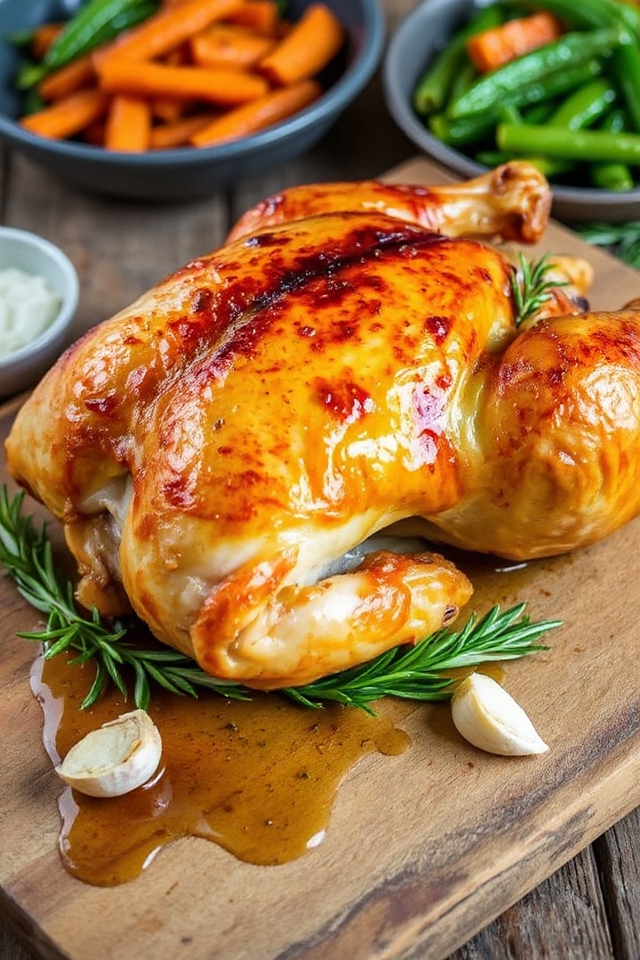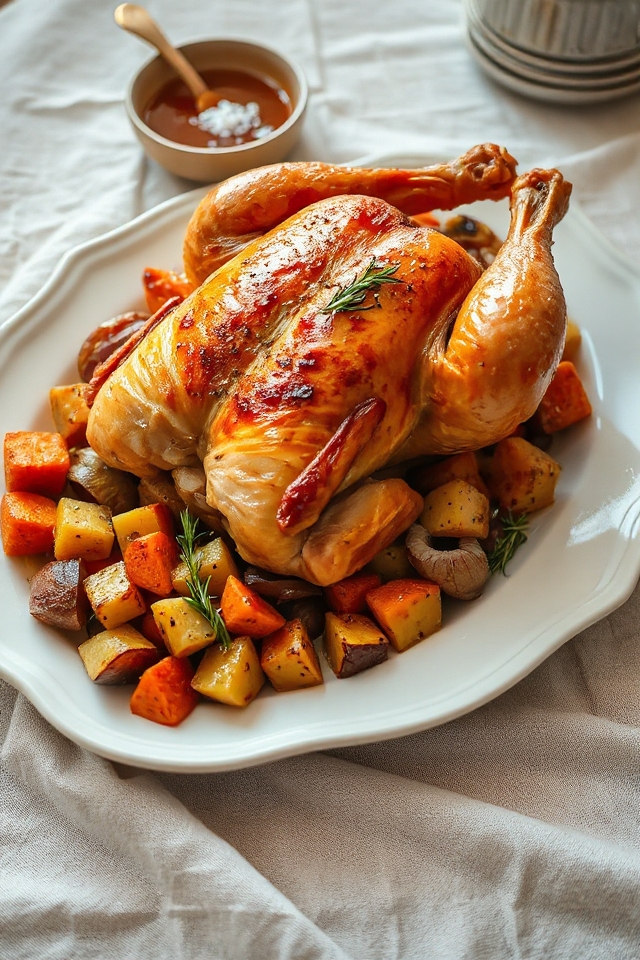Why You’ll Love this Buttermilk Roast Chicken Recipe
If you’ve ever craved a dish that combines juicy, tender meat with a burst of flavor, you’ll love this Buttermilk Roast Chicken recipe.
It’s incredibly easy to prepare, and the marinating process infuses the chicken with rich, tangy notes that make every bite unforgettable. The buttermilk not only tenderizes the meat but also creates a beautifully golden, crispy skin.
I can’t get enough of how the garlic and rosemary elevate the dish, giving it a homey aroma that fills my kitchen.
Whether it’s a weeknight dinner or a special occasion, this roast chicken never disappoints. Trust me; you’ll be hooked!
Ingredients of Buttermilk Roast Chicken
When it comes to making Buttermilk Roast Chicken, the ingredients are key to achieving that perfect blend of flavors and textures. You won’t believe how simple they are, yet they come together to create something truly special.
This dish is all about using quality ingredients, so let’s break it down for you. Here’s what you’ll need to whip up this delicious meal.
- 1 (4 lb) roasting chicken
- 2 cups buttermilk
- 1/4 cup canola oil (plus an additional 2 tablespoons)
- 2 garlic cloves, lightly crushed
- 1 tablespoon crushed black peppercorns
- 1 tablespoon sea salt
- 2 tablespoons fresh rosemary leaves, roughly chopped
- 1 tablespoon honey
Now, let’s chat about the ingredients a bit. The buttermilk is the true star here; it’s what makes the chicken so tender and juicy. Ever tried a dry roast chicken? It’s a culinary tragedy.
But with that tangy buttermilk, you’re set for success. And don’t skimp on the fresh rosemary; it adds this wonderful earthy aroma that just makes your kitchen smell like a cozy Italian bistro.
As for the honey, it brings a lovely hint of sweetness that balances the savory notes beautifully.
Oh, and if you’re wondering about substitutions, you could use olive oil instead of canola if that’s what you have on hand. Just remember, cooking is all about using what you love and have available. Happy cooking!
How to Make Buttermilk Roast Chicken

To make a mouthwatering Buttermilk Roast Chicken, you’ll want to kick things off with a bit of prep work. First things first, you need to butterfly your chicken. This may sound intimidating, but it’s really just a fancy way of saying, “Let’s cut it open and flatten it out.”
Flip your 4-pound roasting chicken breast side down on a cutting board. Grab your heavy-duty kitchen shears and cut along both sides of the backbone—don’t worry if it feels like you’re wrestling a small animal; just channel your inner chef. Once you’ve snipped away that backbone, flip the chicken over and press down gently to flatten it. Voilà, you’ve just transformed your bird into a beautiful canvas for flavor.
Now comes the fun part—marinating. Grab a large freezer bag and put your butterflied chicken inside. In a bowl, mix together 2 cups of buttermilk, 1/4 cup of canola oil, 2 lightly crushed garlic cloves, 1 tablespoon of crushed black peppercorns, 1 tablespoon of sea salt, 2 tablespoons of roughly chopped fresh rosemary, and 1 tablespoon of honey.
This blend is like a flavor party, and trust me, you want to invite your chicken to join. Pour this delightful marinade over your chicken in the bag, seal it up, and let it chill in the refrigerator for at least overnight or up to two days. This is where the magic happens, as the buttermilk tenderizes the meat and infuses it with flavor. Just try not to peek too often; you don’t want to ruin the surprise of that perfectly roasted chicken.
When you’re ready to cook, preheat your oven to 400°F. Remove the chicken from the marinade and let any excess drip off—nobody likes a soggy roast. Line a roasting pan with foil for easy clean-up (thank me later), set your chicken on a rack in the pan, and drizzle with the remaining 2 tablespoons of canola oil.
Roast it in the oven for about 45 minutes, then lower the heat to 325°F and keep roasting until the chicken is golden brown and the juices run clear when you poke it where the leg meets the thigh, which should take another 20 minutes or so. It’s all about that sizzling sound and the aroma wafting through your kitchen.
Once it’s done, let it rest for 10 minutes before you explore. This is essential; it allows the juices to redistribute, rather than all running out when you cut into it. Serve it up, drizzled with those delicious pan juices, and watch as your family or friends swoon. You might even want to take a bow.
Buttermilk Roast Chicken Substitutions & Variations
After you’ve mastered the art of making Buttermilk Roast Chicken, you might wonder how to mix things up or cater to different tastes.
You can swap the buttermilk for yogurt or even coconut milk for a dairy-free option. Instead of rosemary, try thyme or dill to change the flavor profile. For a spicy kick, add cayenne pepper or smoked paprika to the marinade.
If you’re short on time, using chicken thighs instead of a whole bird works just as well. Each variation keeps that juicy, tender essence while allowing you to explore new flavor dimensions.
Enjoy experimenting!
What to Serve with Buttermilk Roast Chicken
While Buttermilk Roast Chicken stands out as a delicious centerpiece, the right side dishes can elevate your meal to new heights.
I love pairing it with creamy mashed potatoes, which soak up the savory juices perfectly. Roasted vegetables, like Brussels sprouts or carrots, add a delightful crunch and vibrant color.
A fresh green salad with a zesty vinaigrette brightens the plate and balances the richness of the chicken. For a comforting touch, consider serving cornbread or crusty bread to mop up those tasty pan drippings.
Trust me, these sides will make your Buttermilk Roast Chicken meal unforgettable!
Additional Tips & Notes
Pairing Buttermilk Roast Chicken with the right sides enhances the overall experience, but there are also some tips to guarantee your chicken turns out perfectly every time.
First, don’t skip the marinating step—it’s key for flavor and moisture. I also recommend using a meat thermometer; the internal temperature should reach 165°F for safe eating.
Letting the chicken rest for 10 minutes after roasting helps retain juicy goodness.
Finally, feel free to customize the herbs and spices in the marinade to suit your taste. Trust me, these little tweaks can elevate your roast chicken to a whole new level!
